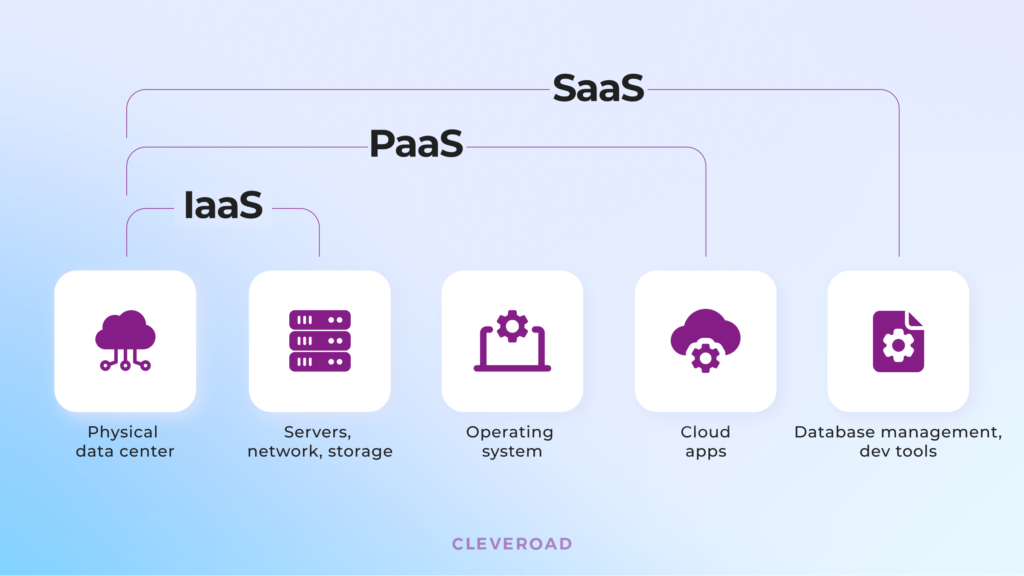In recent years, using the cloud to manage and deliver software applications has grown in popularity. Organizations can now host their applications in the cloud using third-party providers rather than developing and maintaining their own physical infrastructure, enabling users to access them from any location with an internet connection. Yet, there are various different sorts of cloud development models, each with its own unique advantages and downsides. The three most popular cloud development models will be discussed in this blog post: Infrastructure as a Service (IaaS), Platform as a Service (PaaS), and Software as a Service (SaaS).

Infrastructure as a Service (IaaS)
Infrastructure as a Service (IaaS) is the most basic type of cloud development model. With IaaS, developers are responsible for managing their own software applications, but the underlying infrastructure is provided by a third-party provider. This means that organizations can access computing resources like virtual machines, storage, and networking hardware without having to purchase and maintain the physical hardware themselves.
One of the biggest benefits of IaaS is the flexibility it provides. Developers can easily scale their infrastructure up or down based on their needs, without having to worry about the costs and complexity associated with managing their own physical infrastructure. Additionally, IaaS allows developers to customize their infrastructure to meet their specific needs, rather than being limited by the capabilities of a pre-defined platform.
However, IaaS also requires a significant amount of technical expertise to manage and configure the infrastructure. Organizations need to have a dedicated team of developers and IT professionals who are familiar with the underlying infrastructure and can configure it to meet their needs. This can be a significant barrier to entry for smaller organizations or startups that may not have the resources to invest in a dedicated team.
Platform as a Service (PaaS)
Platform as a Service (PaaS) is a more advanced type of cloud development model that provides a pre-defined platform for developers to build and deploy their software applications. With PaaS, developers are responsible for managing their own applications, but the underlying infrastructure and platform are provided by a third-party provider.
One of the biggest benefits of PaaS is the speed and ease of development it provides. Developers can quickly build and deploy their applications without having to worry about managing the underlying infrastructure. Additionally, PaaS platforms often include pre-built components and services that can be easily integrated into applications, further reducing development time and complexity.
However, PaaS also comes with some limitations. Developers are limited to the capabilities and features provided by the platform, and may not be able to customize the underlying infrastructure to meet their specific needs. Additionally, PaaS can be more expensive than IaaS, as organizations are paying for the convenience and ease of use provided by the pre-built platform.
Software as a Service (SaaS)
Software as a Service (SaaS) is the most advanced type of cloud development model, providing a complete software application that is hosted and managed by a third-party provider. With SaaS, developers do not have to worry about managing the underlying infrastructure or platform, as everything is provided by the third-party provider.
One of the biggest benefits of SaaS is the ease of use it provides for end users. Users can access the application from anywhere with an internet connection, without having to worry about installing or maintaining the software themselves. Additionally, SaaS providers often include automatic updates and maintenance, ensuring that the software is always up-to-date and secure.
However, SaaS also comes with some limitations. Developers are limited to the features and capabilities provided by the SaaS provider, and may not be able to customize the application to meet their specific needs. Additionally, SaaS can be more expensive than other cloud development models, as organizations are paying for the convenience and ease of use provided by the complete software application
Diagram representation of the areas covered

Conclusion
A cloud-based programme takes a lot of time and effort to develop. Yet, if done properly, your software can succeed and offer a tonne of value to customers.
